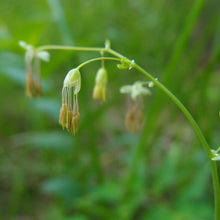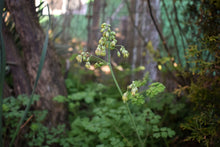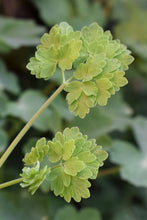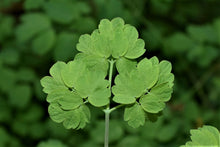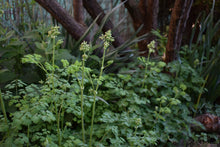
Thalictrum occidentale
Western meadowrue is a delicate woodland perennial with intricately lacey foliage and stunningly unique flowers. It is dioecious, meaning male and female flowers occur on separate plants (each plant is either entirely male or female) in late spring and early summer. Male flowers resemble miniature chandeliers, with dangling yellow to purple tinged stamen that sway eloquently in the breeze. Female flowers are burgundy pom-poms exploding on the ends of the stems. Both male and female plants need to be present for the female plant to produce fruits and eventually seeds.
- Plant type/canopy layer: deciduous perennial herbaceous plant
- Size at maturity: 12' - 36" tall, each plant is about 12” wide, spreads laterally by rhizomes to create a lovely patch over time
- Light requirements: parcial sun to full shade
- Moisture requirements: moist soil
- Bloom time: April - August (generally April - July in the Portland Metro area)
- Growth rate/ease: easy to grow, moderate growth rate
- Wildlife support: overall plant is believed to be a caterpillar host and larval food source for a couple species of native moths
- Native habitat/range: locally common growing in forest openings, woodlands, and along streams, at low elevations, from British Columbia to northern California. Portland Plant List - yes.
- Special features & uses: groundcover; landscape uses include meadowscapes, woodland gardens and erosion control; young leaves are edible raw or cooked and are said to have a faintly sweet flavor; medicinally the roots, which contain a highly antiseptic/antibacterial chemical called berberine, and can be used in tea for colds, as a poultice for rheumatism, and chewed to reduce phlegm, improve blood circulation, and to treat diarrhea. However, always verify with multiple sources when consuming and wildcrafting as many species in the Buttercup family (Ranunculaceae) are toxic; ethnobotanical uses include burning the plants as an insect-repellent and using the seeds and flowers as a perfume and love potion
Gardening with Western Meadowrue: When happily planted in the right place, this sweet species will spread laterally to create lush patches of tall groundcover in the woodland garden. It prefers partial shade areas with moist soils that are high in organic matter. Although it’s known to spread (some lists even say “vigorously”), it is incredibly attractive and not a nuisance. In Sparrowhawk’s garden, there is a lovely patch growing in the dappled light under a mature elderberry shrub. After eight years, the patch is only about 6’ long by 3’ wide. This plant also holds up exceptionally well throughout the growing season and can still be attractive into late summer, when much of the habitat garden is dying back. It looks the best, the longest, particularly if it is planted in a moist area or provided infrequent, but deep, waterings during the summer drought (i.e. once every couple of weeks).
Photo Credits: Nikkie West, Sparrowhawk Native Plants






